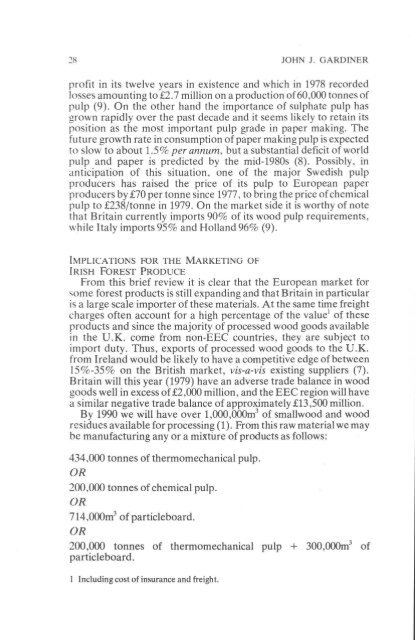Download Full PDF - 30.01 MB - The Society of Irish Foresters
Download Full PDF - 30.01 MB - The Society of Irish Foresters
Download Full PDF - 30.01 MB - The Society of Irish Foresters
You also want an ePaper? Increase the reach of your titles
YUMPU automatically turns print PDFs into web optimized ePapers that Google loves.
JOHN J. GARDINER<br />
pr<strong>of</strong>it in its twelve years in existence and which in 1978 recorded<br />
losses amounting to £2.7 million on a production <strong>of</strong> 60,000 tonnes <strong>of</strong><br />
pulp (9). On the other hand the importance <strong>of</strong> sulphate pulp has<br />
grown rapidly over the past decade and it seems likely to retain its<br />
position as the most important pulp grade in paper making. <strong>The</strong><br />
future growth rate in consumption <strong>of</strong> paper making pulp is expected<br />
to slow to about 1.5% per annum, but a substantial deficit <strong>of</strong> world<br />
pulp and paper is predicted by the mid-1980s (8). Possibly, in<br />
anticipation <strong>of</strong> this situation, one <strong>of</strong> the major Swedish pulp<br />
producers has raised the price <strong>of</strong> its pulp to European paper<br />
producers by £70 per tonne since 1977, to bring the price <strong>of</strong> chemical<br />
pulp to £238/tonne in 1979. On the market side it is worthy <strong>of</strong> note<br />
that Britain currently imports 90% <strong>of</strong> its wood pulp requirements,<br />
while Italy imports 95% and Holland 96% (9).<br />
IMPLICATIONS FOR THE MARKETING OF<br />
IRISH FOREST PRODUCE<br />
From this brief review it is clear that the European market for<br />
some forest products is still expanding and that Britain in particular<br />
is a large scale importer <strong>of</strong> these materials. At the same time freight<br />
charges <strong>of</strong>ten account for a high percentage <strong>of</strong> the value l <strong>of</strong> these<br />
products and since the majority <strong>of</strong> processed wood goods available<br />
in the U.K. come from non-EEC countries, they are subject to<br />
import duty. Thus, exports <strong>of</strong> processed wood goods to the U.K.<br />
from Ireland would be likely to have a competitive edge <strong>of</strong> between<br />
15%-35% on the British market, vis-a-vis existing suppliers (7).<br />
Britain will this year (1979) have an adverse trade balance in wood<br />
goods well in excess <strong>of</strong> £2,000 million, and the EEC region will have<br />
a similar negative trade balance <strong>of</strong> approximately £13,500 million.<br />
By 1990 we will have over 1,000,000m 3 <strong>of</strong> smallwood and wood<br />
residues available for processing (1). From this raw material we may<br />
be manufacturing any or a mixture <strong>of</strong> products as follows:<br />
434,000 tonnes <strong>of</strong> thermomechanical pulp.<br />
OR<br />
200,000 tonnes <strong>of</strong> chemical pulp.<br />
OR<br />
714,OOOm 3 0fparticleboard.<br />
OR<br />
200,000 tonnes <strong>of</strong> thermomechanical pulp + 300,OOOm 3 <strong>of</strong><br />
particleboard.<br />
I Including cost <strong>of</strong> insurance and freight.
















